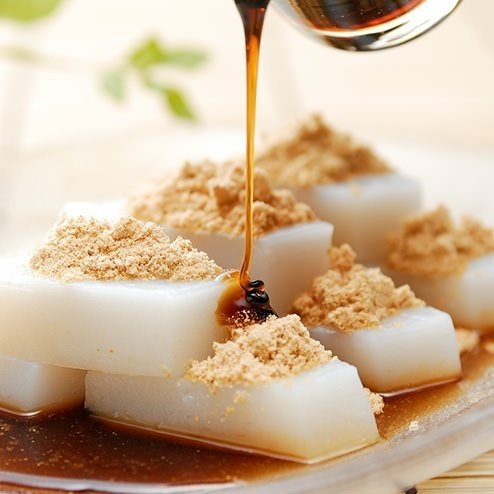
Dig Japan vol.9 “Kuzumochi (葛餅/久寿餅)”
Dig Japan is a series in which I research and introduce in English topics related to traditional Japanese culture that interest me. In this article, I will introduce kuzumochi.
Kuzumochi is one of wagashi, and although it has the same name, there are two types, mainly in Kansai and Kanto, with different recipes. Both types are often enjoyed with kuromitsu syrup or kinako. Besides, kuzumochi in Okinawa is also made from sweet potato starch called imokuzu instead of arrowroot starch. In this article, I will focus on kusumochi from the Kanto region and unravel its history.

Before talking about Kanto's kuzumochi, let me introduce a little about Kansai's one. Kuzumochi from the Kansai region refers to those made by heating and kneading arrowroot powder and sugar, then pouring it into a mold to harden it, or wrapping it in azuki bean paste like kuzumanju. Its translucent appearance gives it a refreshing feel, making it one of popular summer sweets.
On the other hand, in the Kanto region, kusumochi is a confectionery made from fermented wheat starch, steamed, and cut into triangles. The color is milky white and the taste is slightly sour. The origin of kusumochi dates back to around 1830. There lived a man named Kyubei around that time. On a windy and rainy night, the flour he had stored in his barn got wet, so he kneaded it, displaced it to a barrel, dissolved it in water, and left it there.

When the next year's famine occurred, he remembered this and found that the flour had fermented and that pure starch had settled at the bottom of the barrel. It smelled so bad, he washed the starch for several days to get rid of the smell, and although it still smelled a bit, he steamed the starch because he was really hungry. As a result, a unique rice cake was created, and it is allegedly the origin of the Edo's kusumochi. He distributed this to the hungry villagers and became a hero who saved them from famine.
Kusumochi of the Kanto region is made by fermenting starch refined from wheat flour with lactic acid bacteria, and does not contain arrowroot starch as an ingredient. It looks white and does not have the transparency of kuzumochi. The texture is also solider than Kansai's one and has a unique flavor. However, it is eaten the same way as kuzumochi of Kansai, served with kuromitsu or kinako. Also, new flavorings like ramune (soda pop) flavor, and new sweets such as cutting kusumochi into small dice and making tapioca-style drinks are being devised and commercialized.
This article was written by 𝐡𝐢𝐫𝐨𝐤𝐨, working as a freelance translator and PR for overseas apparel brands in Japan, with the aim of broadening her own knowledge of traditional Japanese culture and spreading it to the world.
いつも読んでくださってありがとうございます☺︎いただいたサポートは、記事のクオリティ向上に活用させていただきます。応援よろしくお願いします❦
